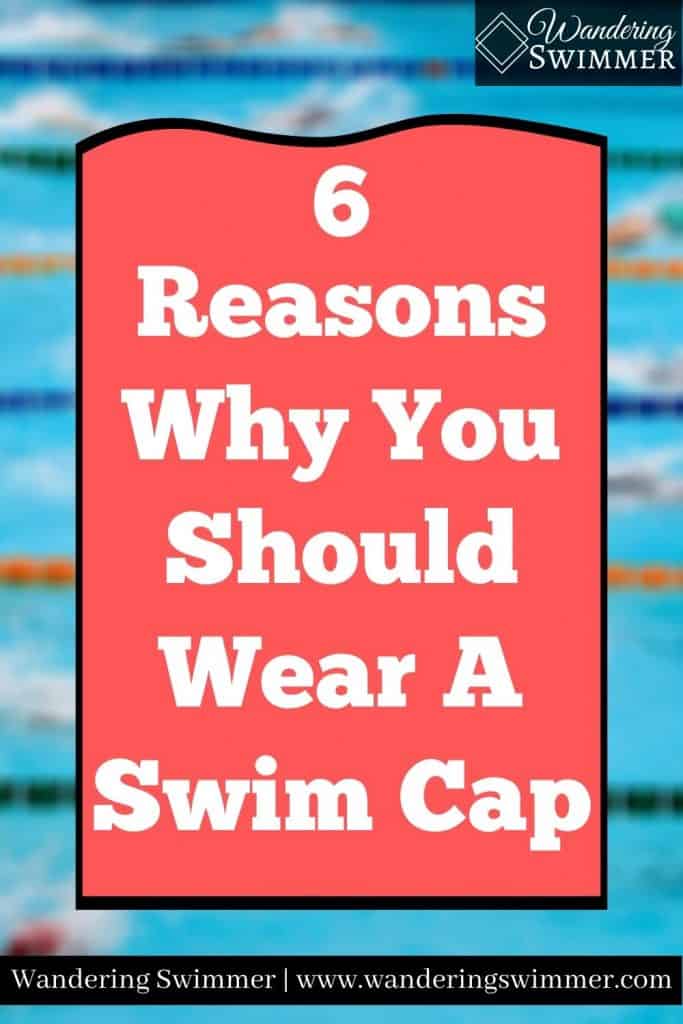Written By: Chevron
Swim caps are a necessary evil and swimmers love to hate them. As a swimmer of twenty years, I can personally say that while yes, they can be a pain, they also provide many additional benefits to me. And that, yes, they’re worth the hassle.
Related articles: Your Quick Guide to Swim Caps
Disclosure: This post may contain affiliate links, meaning I earn a small commission at no cost to you if you purchase something through one of my links. As an Amazon Associate, I earn from qualifying purchases. Please check out my disclosure page for more information.

1. Safety
Swim caps are a safety measure in the pool and in open water.
When you’re swimming laps in a pool, swim caps help keep your hair out of your face when you swim. For those with long hair, this is especially important because long hair can cover your eyes/goggles and prevent you from seeing well in the water.
This makes you more prone to running into another swimmer, the wall, or the lane line.
You also run the risk of getting chunks of your own hair in your mouth whenever you try to breathe. While you probably won’t inhale/swallow it, it can still temporarily restrict your breathing, which can lead to a scary experience.
The few times I did swim without a cap when I had long hair, I would have it pulled back into a ponytail and then braid the ponytail itself. This way, it kept my vision from being obstructed and my breathing unimpeded.
This is an option if you’re determined not to swim with a cap. Just note that if you have bangs, you’ll want to pin them back or they’ll still get in your face.
What if you have short hair? You’ll still shed hair in the pool. But in terms of safety, it depends on how short your hair is. If you’re rocking a tight pixie cut, your hair probably won’t get in your face or your mouth. And you could swim without a swim cap.
These last few years of my swimming, I’ve kept my hair extremely short but I still wear a swim cap. I tried it once and I didn’t like the way the water moved over my ears.
1a. Open Water Safety
When swimming in open water, such as a lake or ocean, wearing a brightly colored cap can save your life. The bright color in an otherwise dark and matching surface (water meting sky) helps you stand out.
This can help not just lifeguards and other swimmers see you, but also boaters and other water craft.
You should also wear an open water swim buoy as it adds to the bright colors to keep you visible.
Lastly, swim caps in open water can help retain body heat in the cooler seasons. Neoprene swim caps specifically are designed to keep your head warm.
While you may be able to get away with not wearing a swim cap in the pool, I cannot stress enough that you should wear a bright swim cap when open water safety. It may be the difference between life and death.
2. Protects My Hair
The chemicals in the pool are notorious for damaging hair. Turning your smooth, silky hair into something thick and straw-like. And while it’s the copper, not chlorine, in the chemicals that can turn hair green, it’s something most people don’t want to deal with.
Even with products to help remove chlorine from your hair, wearing a swim cap helps your hair stay healthy. Silicone and latex swim caps are the best at keeping your hair dry. Whereas a lycra cap doesn’t offer as much protection from the water.
The few times I’ve swam without a swim cap, it felt like it took days for my hair to feel normal and not heavy with chemicals.
Related article: 7 Common Swimming Myths
A swim cap won’t keep your hair 100% dry, but it can still help protect it from chemicals. It can also keep your hair protected from the sun, too!
3. Hassle Free Hair Maintenance
This is probably an unpopular opinion by most, but for me, wearing a swim cap when I swim laps is less hassle than not wearing one.
It’s far easier to pull my hair back and put a cap on, and not have to worry about anything getting in my face. Just as it makes it so much easier to maintain my hair’s health. I don’t have to buy special products to remove chlorine from my hair and at most, I’ll apply a hair mask after my Saturday swim.
For me, the time and cost it saves in not having to deal additional products or fight with knots in my hair far outweigh any discomfort a swim cap brings me.
And honestly, the only time it really bothers me is when both the air and water are too hot and I need to cool down. Even then, I can take off the cap to cool off and I’m ready to go.
4. Keeps Hair Out of the Pool
Swim caps also help prevent hair, especially long hair, from floating through the pool and building up into a hairball.
When you swim without a swim cap, your hair does shed – much like it would out of the water. This then builds up in the water and either sticks to someone’s face. Or forms a large, rolling hairball that tumbles along the bottom of the pool, collecting everything.
Nothing is worse than getting someone else’s hair caught in your fingers or on your face. I’ve been victim to more than my fair share of stray strands and globs of hair catching on my body throughout my swimming years.
It’s disgusting and is also unsanitary, as these hairballs can clump together and start to pick up everything at the bottom of the pool. Such as band-aids.
More Content for You: How to Make Your Swimsuit Last Longer
5. Helps Me Swim Faster
Although many people think that a cap was designed to keep your hair dry, it’s actually to reduce drag! I.e., make swimmers faster!
Is it a noticeable difference to the casual lap swimmer? Probably not. But for a competitive swimmer, a swim cap is the difference between first and second place. In fact, I wear a specially designed cap at swim meets called a dome cap to help me swim faster.
More Content for You: 4 Ways to Prevent Swimmer’s Ear
And as a lap swimmer, it may not make a large, noticeable difference but it should make you feel a smidge faster. If only because you’re dealing with the weight of wet hair trailing behind you and getting in your way.
6. Helps Your Fans (Parents) Spot You in the Pool
For those in competitive swimming, you know that once you get in the pool, everyone looks the same. Trying to find someone and point them out in a crowded warm-up pool is like playing Where’s Waldo.
Having a swim cap on though can help eliminate part of the search. Just by looking for your team name or logo, or even a team color makes it easier to spot swimmers on the deck or in the water. My mom always knows where I’m at in the pool by looking for my cap!
As a lap swimmer, swim caps can you find your friends in the pool if they’ve already started swimming before you. And, good or bad, it can help a lifeguard identify you.
Bonus! #7: Protects Your Ears
As a bonus, swim caps also help with keeping water out of your ears if they’re covering your ears. While it won’t keep them 100% dry, it does help keep them from being submerged all the time.
I’ve also found that caps also help keep swimming earplugs in place when I’m swimming. I use silicone type ear plugs and I feel they fit more snug with the cap holding them in place.
But is it Bad to Swim Without a Cap?
Not really, if that’s your preference. You can get by without wearing a swim cap the next time you’re at the pool.
But if you’re looking to get in some laps or start competitive swimming, it’s a good idea to wear one. And of course, I highly, highly encourage you to wear a swim cap if you’re doing open water swimming.
I’ll also note that some pools do require you to wear a swim cap whenever you’re in the pool. So while it’s not bad to swim without a cap, always check your local pool rules.
Related article: Your Ultimate Swim Cap FAQ
Bonus Content:
Swimming Basics to Get You Started: If you just started to swim, you might feel that swimming can be overwhelming. Here are some swimming basics to help you feel more comfortable at the pool.
8 Reasons Your Swim Cap Slides Off: Trying to keep your swim cap on though is a challenge. There’s no one secret to keep it in place but there are some reasons why your swim cap slides off.
About

Chevron is a current competitive swimmer with almost 20 years of experience at the local, national and international level. A current USA Swimming and US Masters Swimming athlete, she’s committed to providing guidance to all levels of swimmers and believes that everyone should know how to swim.
thank you this was very helpful